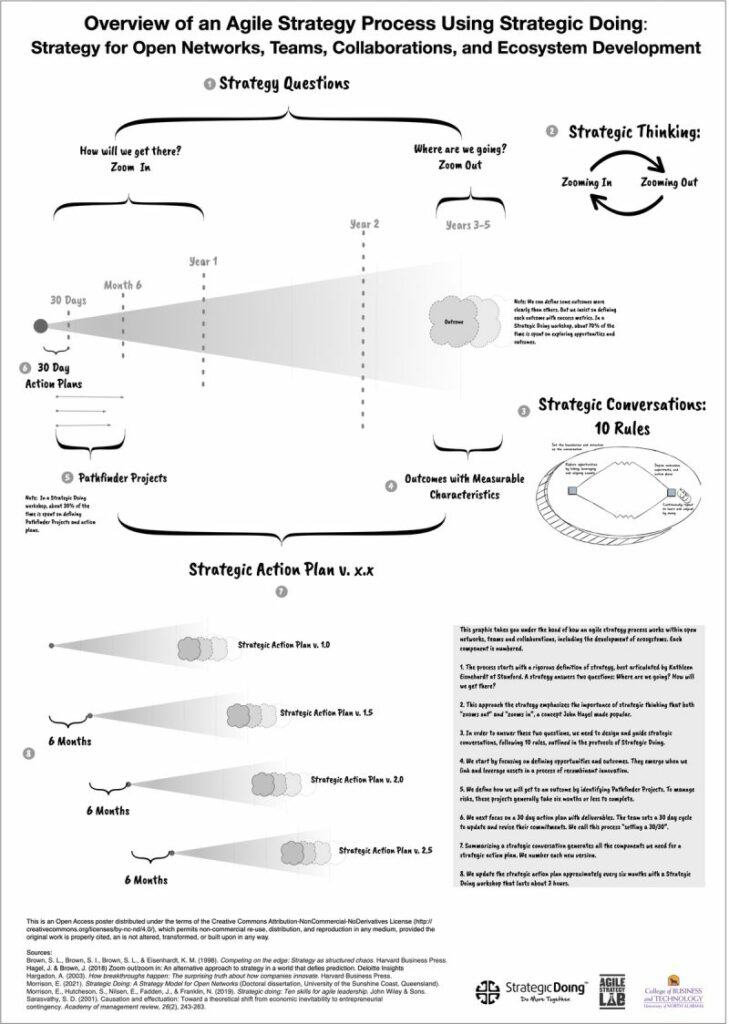Strategic Doing Under the Hood

This graphic takes you under the hood of how an agile strategy process works within open networks, teams, and collaborations, including the development of ecosystems. Here are the key points:
1. The process starts with a rigorous definition of strategy in dynamic markets, best articulated by Kathleen Eisenhardt at Stanford. A strategy answers two questions: Where are we going? How will we get there?
2. This approach to strategy in dynamic markets emphasizes the importance of strategic thinking that both “zooms out” and “zooms in”. John Hagel and John Seely Brown of Deloitte first presented the concept.
3. In order to answer these two questions, we need to design and guide strategic conversations, following 10 rules, outlined in the protocols of Strategic Doing. (These rules are outlined in the book and dissertation below.)
4. We start by focusing on defining opportunities and outcomes. They emerge when we link and leverage assets in a process of recombinant innovation. This process follows an entrepreneurial or “effectual” logic. This segment of the conversation builds shared commitment through a process that psychologists call “collective prospection”.
5. We define how we will get to an outcome by identifying Pathfinder Projects. To manage risks, these projects generally take six months or less to complete. They test our assumptions, and, if successful, they provide us with small wins that build momentum. Small wins are critical to developing solutions to wicked problems.
6. We next focus on a 30-day action plan with deliverables. The team sets a 30-day cycle to update and revise their commitments. We call this process “setting a 30/30”. Creating stable patterns of matching our words with our actions creates the conditions for trust to emerge across the collaboration.
7. Summarizing a strategic conversation generates all the components we need for a strategic action plan. We number each new version.
8. We update the strategic action plan approximately every six months with a Strategic Doing workshop that lasts about 3 hours.
Strategy in dynamic markets increasingly requires collaborations. To develop strategies for these collaborations, new protocols provide a pathway forward.
Although these protocols take practice to master, they are open-source, fast, low-cost, replicable, and scalable. They focus on mastering our oldest technology: conversation.
Note: To understand why conversation is so critical in a knowledge economy, read Alan Webber’s important, but largely neglected article in the Harvard Business Review, “What’s so new about the new economy?” (written almost 30 years ago: https://bit.ly/30eVN1y)
PDF of the poster is available here: https://bit.ly/3sail1o
====
Learn more:
Strategic Doing Book: http://bit.ly/2Kkwk19
Podcast: https://bit.ly/CBMorrison
Strategic Doing Dissertation: https://bit.ly/SDPhD
Agile Strategy Lab: bit.ly/AgileStrategyLab

The Founder of the Lab at UNA and co-author of Strategic Doing: 10 Skills for Agile Leadership, Ed’s work has focused on developing new models of strategy specifically designed to accelerate complex collaboration in networks and open innovation. He is the original developer of Strategic Doing.
